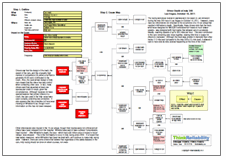By Kim Smiley
The racing world was filled with sadness with the death of Dan Wheldon during the Indy 300 race in Las Vegas on October 16, 2011. However, many race-car drivers were not shocked at the occurrence of a 15-car pileup that resulted in Wheldon’s death. Specifically, these drivers note that the track – which was designed for NASCAR vehicles which travel at much slower speeds – was designed with high banks that allowed cars to accelerate heavily, reaching speeds of up to 225 miles per hour. This also contributed to the cars remaining very close together, leaving little time or space for drivers to maneuver. Although the track was smaller in diameter than other tracks (1.5 mile oval compared to the Indy 500’s 2.5 mile oval), it allowed 4 cars to race side by side, as was happening at the time of the crash.
 Drivers say that the design of the track, the speed of the cars, and the unusually high number of competitors (34, when a full field is generally 26-28 cars) contributed to the crash. Also, the open wheel design of Indy cars means that the driver has less control when contacting other cars. In fact, many drivers said they expected at least one spectacular crash to result, given the circumstances. Although racecars do have special features that protect drivers in a crash, the cars used in the Indy races have open cockpits, providing less protection. It also appears that the protective roll hoop was missing on Wheldon’s car, though more information on this has not been released.
Drivers say that the design of the track, the speed of the cars, and the unusually high number of competitors (34, when a full field is generally 26-28 cars) contributed to the crash. Also, the open wheel design of Indy cars means that the driver has less control when contacting other cars. In fact, many drivers said they expected at least one spectacular crash to result, given the circumstances. Although racecars do have special features that protect drivers in a crash, the cars used in the Indy races have open cockpits, providing less protection. It also appears that the protective roll hoop was missing on Wheldon’s car, though more information on this has not been released.
Other drivers were also injured in the 15-car pileup, though their injuries were not critical and all others have been released from the hospital. Wheldon was said to have suffered “unsurvivable head injuries”. After Wheldon’s death, the race – which had a $5 million prize in hopes to boost ratings – was stopped. This is the first fatality to occur in Indy racing since 2006. It is hoped that new safety measures – which Wheldon had been involved with – will continue to make Indy racing safer. However, there are some drivers that believe that regardless of the safety features in the cars, Indy racing should be done on street courses, not ovals.
To view the Outline and Cause Map, please click “Download PDF” above.

